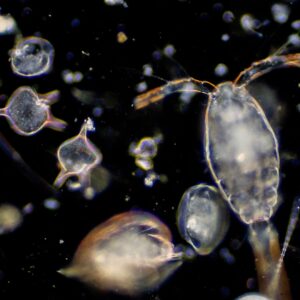Plankton
Interstate Commission on the Potomac River Basin
Life in a Drop of Water: Phytoplankton and Zooplankton
 Plankton are free-floating microscopic algae (phyto-) and animals (zoo-). They are a principal source of food in open waters such as lakes, large rivers, and estuaries where they directly or indirectly support much of the upper levels of the food web.
Plankton are free-floating microscopic algae (phyto-) and animals (zoo-). They are a principal source of food in open waters such as lakes, large rivers, and estuaries where they directly or indirectly support much of the upper levels of the food web.
- Phytoplankton Index of Biotic Integrity (PIBI): A multi-metric index for phytoplankton in Chesapeake’s tidal fresh and estuarine waters can numerically quantify their community status.
- Zooplankton Indicators: The approach used to develop the PIBI was successfully used to develop an IBI for polyhaline zooplankton.
Other ICPRB plankton projects and reports
• Phytoplankton Nutrient Limitation
• Water Quality Binning Method
• Larval Striped Bass Habitat Index
• Chlorophyll Criteria
Phytoplankton Index of Biotic Integrity (PIBI)
Led by ICPRB staff, researchers developed a phytoplankton index of biotic integrity (PIBI) for the Bay in 2005/6 from long-term spring and summer monitoring data and re-validated it with new data in 2013. A water quality binning method combined different levels of water clarity (Secchi depth), dissolved inorganic nitrogen (DIN), and ortho-phosphate (PO4) to create distinct water quality categories (bins) and establish a plankton disturbance spectrum. High quality, “reference” conditions have adequate light for normal plant growth and concentrations of nitrogen and phosphorus low enough to limit algal bloom formation. These are the water quality conditions desired in a restored Chesapeake Bay.
Community-level phytoplankton metrics (e.g., chlorophyll, diatom biomass, dinoflagellate biomass) that most strongly discriminated between reference and degraded conditions were identified, scored, and combined to create the index. The classification efficiencies of the index ranged between 70% and 90% depending on salinity zone and season. The index characterizes balanced, “healthy”, desirable phytoplankton populations in different seasons and salinity zones and is used by resource managers to track progress in Bay restoration.
These publications and reports describe the index development and some preliminary and follow-up studies in more detail.
- Buchanan, C., R. V. Lacouture, H. G. Marshall, M. Olson, and J. Johnson. 2005. Phytoplankton reference communities for Chesapeake Bay and its tidal tributaries. Estuaries 28(1):138-159. https://doi.org/10.1007/BF02732760.
- Measurements of C:Chl a, Pmax, Topt, and Other Model Parameters in Natural Phytoplankton Populations of the Chesapeake Estuaries (ICPRB Report 06-1)
- Lacouture, R. V., J. M. Johnson, C. Buchanan, and H. G. Marshall. 2006. Phytoplankton index of biotic integrity for Chesapeake Bay and its tidal tributaries. Estuaries 29(4):598-616. https://doi.org/10.1007/BF02784285.
- Marshall, H. G., R. V. Lacouture, C. Buchanan, and J. M. Johnson. 2006. Phytoplankton assemblages associated with water quality and salinity regions in Chesapeake Bay, USA. Estuarine Coastal and Shelf Science 69:10-18. https://doi.org/10.1016/j.ecss.2006.03.019.
- Johnson, J. M., and C. Buchanan. 2013. Revisiting the Chesapeake Bay phytoplankton index of biotic integrity. Environmental Monitoring and Assessment 186:1431–1451. https://doi.org/10.1007/s10661-013-3465-z.
- Balanced, indigenous, desirable phytoplankton populations in Virginia tidal waters (ICPRB Report 15-3)
Zooplankton Indicators
Chesapeake Bay researchers have considered developing zooplankton indicators since 1993 (ICPRB Report 93-2, ICPRB Report 94-4). In 2006, a zooplankton index of biotic integrity was developed for summer polyhaline waters of the Chesapeake Bay with data from long-term monitoring data and the water quality categories used to develop the PIBI. Nine zooplankton community metrics showed strong discrimination efficiencies and were selected for the index. They included the Simpson diversity index and abundances of barnacle larvae, rotifers, cladocerans, copepods, total mesozooplankton, and predators. The index correctly classified about 94% of the degraded samples and about 82% of the reference samples for an overall classification efficiency of 88%.
- Carpenter, K. E., J. M Johnson, and C. Buchanan. An index of biotic integrity based on the summer polyhaline zooplankton community of the Chesapeake Bay. 2006. Mar. Env. Res. 62(3):165-180. https://doi.org/10.1016/j.marenvres.2006.03.009.
Return to Aquatic Life Main Page

